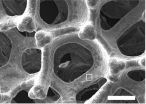Microenvironment provides growth factor for metastasis
Investigators identify new role for cytokine VEGFA in the metastasis of neuroblastoma
2015-03-17
(Press-News.org) Healthy bone is continuously involved in a dynamic process that includes bone deposition and bone resorption. However, when a person has cancer that spreads to the bone and bone marrow, the tissue becomes increasingly fragile, and this process is disrupted, usually leading to increased bone resorption.
In an early online edition in advance of publication in the International Journal of Cancer, investigators at Children's Hospital Los Angeles reported a surprising discovery - when neuroblastoma (NB) cells metastasize to the bone, there initially occurs an increase in bone deposition, not resorption. They also determined that this process is driven by a chemical messenger called VEGFA.
Neuroblastoma is the most common extra-cranial solid tumor occurring during childhood and frequently metastasizes to the bone and bone marrow, making the disease more difficult for doctors to treat and conferring a worse prognosis for patients. Teams of scientists have been working to determine what causes a tumor to metastasize, knowing it is an interaction between tumor cells and the metastatic site, called the microenvironment.
"Metastasis results from a vicious cycle: tumor cells accelerate bone deposition, which releases physiological factors that feed tumor cells," said Josephine H. HaDuong, MD, of Children's Hospital Los Angeles, who is first author on the study. She is also an assistant professor at the Keck School of Medicine of the University of Southern California. HaDuong explains that the microenvironment includes the connective tissue, or stromal cells in the bone marrow, the cells that form and resorb bone along with other cells and growth factors.
Stroma includes a population of pluripotent progenitor cells that are able to become bone, muscle, fat or cartilage. A growth factor called bone morphogenetic protein, or BMP, drives the progenitor cells on the path to form bone. When BMP was added to progenitor and NB cells, the investigators expected bone deposition but they found more of it than anticipated. Using microarray analysis, they determined this increase to be mediated by VEGFA. In other experiments they specifically blocked VEGFA and found an increase in bone-resorbing cells and areas of severe bone loss.
"For years we have known that the microenvironment was key to understanding metastatic neuroblastoma," said principal investigator Yves DeClerck, MD, of the Center for Childhood Cancer and Blood Disorders at CHLA. "Now we have identified a new role for VEGFA, laying the groundwork for the development of therapeutics to target it." DeClerck holds the Richard Call Family Endowed Chair in Pediatric Research Innovation at CHLA, and is a professor at the Keck School of Medicine of the University of Southern California (USC).
INFORMATION:
Additional contributors to the paper include Laurence Blavier, Jemily Malvar and Richard Sposto of The Saban Research Institute of Children's Hospital Los Angeles and USC; Sanjeev K. Baniwal, Baruch Frenkel, and Vasu Punj of USC. This work was funded by a National Institutes of Health grant P01-CA81403 and the Ruth L. Kirschstein National Research Service Award 2-T32-CA 09659.
Link to the article: http://onlinelibrary.wiley.com/doi/10.1002/ijc.29465/full
About Children's Hospital Los Angeles
Children's Hospital Los Angeles has been named the best children's hospital on the West Coast and among the top five in the nation for clinical excellence with its selection to the prestigious U.S. News & World Report Honor Roll. Children's Hospital is home to The Saban Research Institute, one of the largest and most productive pediatric research facilities in the United States. Children's Hospital is also one of America's premier teaching hospitals through its affiliation since 1932 with the Keck School of Medicine of the University of Southern California.
For more information, visit CHLA.org. Follow us on our blog http://researchlablog.org/.
ELSE PRESS RELEASES FROM THIS DATE:
2015-03-17
Berkeley -- Engineers at the University of California, Berkeley, are developing a new type of bandage that does far more than stanch the bleeding from a paper cut or scraped knee. Thanks to advances in flexible electronics, the researchers, in collaboration with colleagues at UC San Francisco, have created a new "smart bandage" that uses electrical currents to detect early tissue damage from pressure ulcers, or bedsores, before they can be seen by human eyes - and while recovery is still possible.
"We set out to create a type of bandage that could detect bedsores as ...
2015-03-17
UNSW Australia scientists have developed a highly efficient oxygen-producing electrode for splitting water that has the potential to be scaled up for industrial production of the clean energy fuel, hydrogen. The new technology is based on an inexpensive, specially coated foam material that lets the bubbles of oxygen escape quickly.
"Our electrode is the most efficient oxygen-producing electrode in alkaline electrolytes reported to date, to the best of our knowledge," says Associate Professor Chuan Zhao, of the UNSW School of Chemistry.
"It is inexpensive, sturdy and simple ...
2015-03-17
Tuesday, March 17, 2015. Just like milk and many other foods, blood used for transfusions is perishable. But contrary to popular belief, new research shows that blood stored for three weeks is just as good as fresh blood - findings published today in the New England Journal of Medicine.
The large clinical trial provides reassuring evidence about the safety of blood routinely transfused to critically ill patients. Supported by the Canadian Critical Care Trials Group and countless nurses, blood bank technologists, transfusion medicine and critical care physicians, Drs. ...
2015-03-17
Ann Arbor, MI, March 17, 2015 -- Suicide is responsible for more than 36,000 deaths in the United States and nearly 1 million deaths worldwide annually. In 2009, suicides surpassed motor vehicle crashes as the leading cause of death by injury in the U.S. A new study published in the American Journal of Preventive Medicine analyzes the upward trend of suicides that take place in the workplace and identifies specific occupations in which individuals are at higher risk. The highest workplace suicide rate is in protective services occupations (5.3 per 1 million), more than ...
2015-03-17
(Chicago) - Just as humans will travel to their favorite restaurant, chimpanzees will travel a farther distance for preferred food sources in non-wild habitats, according to a new study from scientists at Chicago's Lincoln Park Zoo that publishes on March 17 in the journal PeerJ.
Chimpanzees at Lincoln Park Zoo prefer grapes over carrots. Previous research at the zoo provided that insight into food preferences. Now, a 15-month study, led by Lydia Hopper, PhD of the Lester Fisher Center for the Study and Conservation of Apes at Lincoln Park Zoo, suggests that the apes ...
2015-03-17
Toronto, ON (March 17, 2015) - A comprehensive study examining clinical trials of more than 95,000 patients has found that glucose or sugar-lowering medications prescribed to patients with diabetes may pose an increased risk for the development of heart failure in these patients.
"Patients randomized to new or more intensive blood sugar-lowering drugs or strategies to manage diabetes showed an overall 14 per cent increased risk for heart failure," says Dr. Jacob Udell, the study's principal investigator, and cardiologist at the Peter Munk Cardiac Centre, University Health ...
2015-03-16
A new study, "Global Dispersion and Local Diversification of the Methane Seep Microbiome," provides evidence methane seeps are habitats that harbor distinct microbial communities unique from other seafloor ecosystems. The article appeared in the March 16 issue of the Proceedings of the National Academy of Sciences (PNAS).
Methane seeps are natural gas leaks in the sea floor that emit methane into the water. Microorganisms that live on or near these seeps can use the methane as a food source, preventing the gas from collecting in the surrounding hydrosphere or migrating ...
2015-03-16
If you want someone to open up to you, just make them laugh. Sharing a few good giggles and chuckles makes people more willing to tell others something personal about themselves, without even necessarily being aware that they are doing so. These are among the findings of a study led by Alan Gray of University College London in the UK, published in Springer's journal Human Nature.
The act of verbally opening up to someone is a crucial building block that helps to form new relationships and intensify social bonds. Such self-disclosure can be of a highly sensitive nature ...
2015-03-16
Charles R. Wira, PhD, and colleagues at Dartmouth's Geisel School of Medicine have presented a comprehensive review of the role of sex hormones in the geography of the female reproductive tract and evidence supporting a "window of vulnerability" to HIV and other sexually transmitted infections (STIs). Published in Nature Reviews in Immunology, Wira's team presents a body of work that National Institutes of Health evaluators called, "a sea change" for research in the female reproductive tract (FRT).
"The FRT is tremendously complex and the normal changes that occur to ...
2015-03-16
The studies below will be presented at the American College of Cardiology's 64th Annual Scientific Session on Monday, March 16.
1. New Insights on Endurance Sports and Atrial Fibrillation
Previous studies have suggested endurance athletes may face a slightly higher risk of developing atrial fibrillation, a condition in which the heartbeat becomes irregular or rapid. A new study shows that among runners, the total number of years a person has been running is the factor most closely associated with atrial fibrillation risk, as compared to other measures of running behavior ...
LAST 30 PRESS RELEASES:
[Press-News.org] Microenvironment provides growth factor for metastasis
Investigators identify new role for cytokine VEGFA in the metastasis of neuroblastoma


